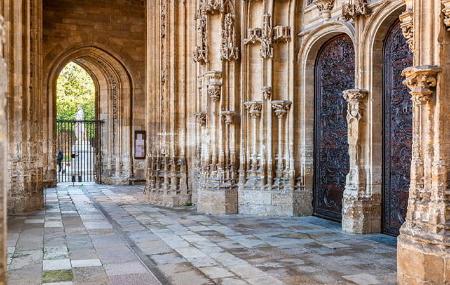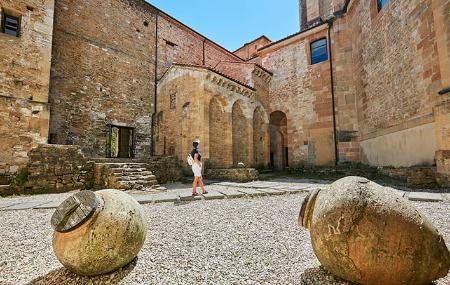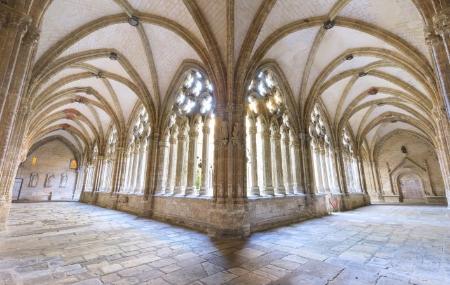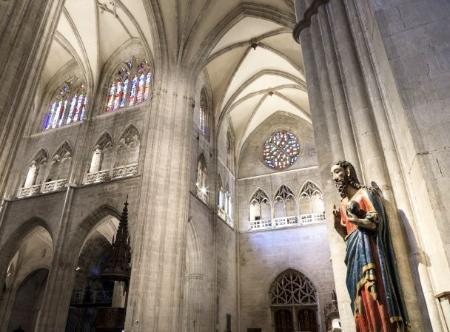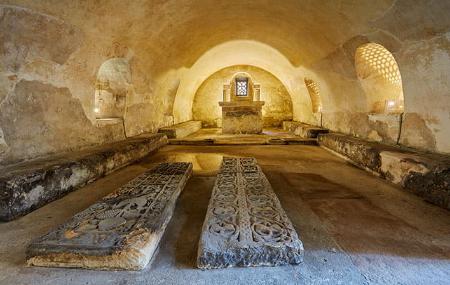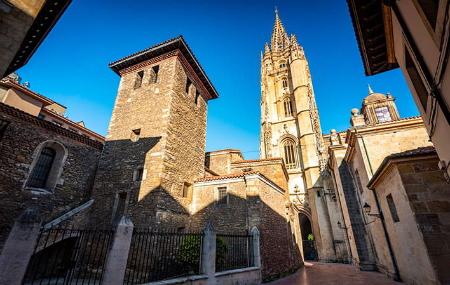
Catedral de El Salvador
- Title Oviedo Centro de Asturias
- Address Address: Pza. de Alfonso II, El Casto ■ 33003 - Oviedo/Uviéu
- Phone Phone: 614 490 811
- Email Email: reservas@catedraldeoviedo.com, catedral@catedraldeoviedo.com
- Site Site: https://catedraldeoviedo.com
- Period Period: Gótico
- Documents Documents: Ficha de accesibilidad
Info
Doce siglos de historia, atesora la Catedral de El Salvador, principalmente por la cantidad y calidad de las reliquias que conserva. Nacida del espíritu que animó el primer reino cristiano de la Península Ibérica, resistente y resiliente frente a la invasión musulmana, la Catedral ha sido siempre y lo sigue siendo un enclave estratégico. Tiene sus orígenes en la basílica mandada construir por el rey Alfonso II el Casto, bajo la advocación de El Salvador. Fue edificada sobre las ruinas de una iglesia anterior levantada por su padre Fruela I.
Durante el siglo XIV comienza la construcción de la Catedral Gótica, demoliéndose la anterior basílica Románica y Prerrománica, dicha construcción finaliza a mediados del siglo XVI, con el remate de la torre, es decir casi tres siglos dura la construcción del templo. Además, fue necesario trabajar durante otros cien años en la construcción de las capillas y panteones que hoy vemos adosados a las naves laterales. Por consiguiente, el proceso completo de construcción de la catedral abarca aproximadamente cuatro siglos, destacando el intenso trabajo durante el siglo XV, época en la que prevalece el estilo gótico florido o flamígero, al que pertenece nuestra catedral.
El edificio se compone de tres naves, siendo la central la mayor, y las laterales con capillas, precedidas por un pórtico. El crucero sobresaliente confiere a la planta una forma de cruz latina, rematada por una cabecera donde se inserta la girola. Durante la Etapa Románica, Alfonso III el Magno enriqueció considerablemente el tesoro catedralicio al donar la Cruz de la Victoria, aunque no llevó a cabo ampliaciones de la basílica de El Salvador. Con el traslado de la corte a León en el siglo X, los monarcas sucesivos, continuaron enriqueciendo la basílica con sus donaciones, lo que le valió un gran prestigio durante la Edad Media y, convirtiéndola en un destino imprescindible para peregrinos y devotos. A esta época pertenecen el apostolado de la Cámara Santa y la Torre Vieja.
En la Etapa Gótica, el Claustro Gótico, sustituyo al románico anterior, destacando el él sus ménsulas y capiteles con una rica y variada iconografía que abarca tanto temas profanos como religiosos, así como leyendas medievales y motivos específicamente asturianos, como la lucha de Favila con el oso. En el muro sur del Claustro se encuentra la Puerta de la Limosna, con figuras esculpidas de Santiago, San Pedro, San Pablo y San Andrés en las jambas, la figura de El Salvador en el tímpano, y la Virgen de la Leche en el pilar central. Junto a esta puerta se sitúa la llamada Capilla de la Hidria, donde, según la tradición, se guarda una hidria de las Bodas de Caná, uno de los milagrosos vestigios más visitados por los peregrinos.
El Pórtico está formado por tres arcos, de diferente tamaño, que tiene su correspondencia en las naves del templo, posteriores, aunque del mismo siglo, son las puertas, en ellas aparecen labrados los relieves de El Salvador y de Santa Eulalia. La Torre Gótica (visitable) está coronada por la aguja con una altura de sesenta metros. El estilo del Retablo Mayor, situado en el ábside de la catedral, oscila entre el gótico flamígero y el Renacimiento. Obra monumental de madera policromada, se divide en cinco calles. En la calle central se representan las escenas principales: la Crucifixión, la Asunción y Coronación de la Virgen y El Salvador. Se considera uno de los mejores retablos góticos españoles junto a los de Sevilla y Toledo.
Ya en la Etapa Barroca, se añade la girola o deambulatorio, hacia la mitad del XVII. Tiene forma heptagonal, con pequeñas capillas que nos ofrecen un grupo de retablos barrocos de acusada influencia italiana. La Sacristía Nueva se añadió en 1733.
En la Catedral nos encontramos con seis capillas, cada una con su propia historia y significado, que enriquecen la experiencia del visitante y revelan la diversidad de estilos y épocas que conforman este monumento... Capilla de Santa Eulalia, Santa Eulalia fue una niña emeritense que vivió su fe cristiana durante las persecuciones del emperador Diocleciano a principios del siglo IV, recibiendo martirio por negarse a adorar a los dioses romanos. El conjunto de la capilla se terminó en 1702. La Capilla de Santa Bárbara, llamada en su momento “de San Miguel” o “Nueva Cámara Santa”, se construyó entre los años 1660 y 1663. El obispo Bernardo Caballero de Paredes, está enterrado a la entrada de esta capilla, para que todos aquellos que entrasen pisasen su tumba, tal y como él había dejado por escrito en su testamento.
Capilla de los Vigiles, en 1615 el cabildo catedralicio cedió al gijonés Juan Vigil de Quiñones, obispo de Valladolid y Segovia, la capilla situada en el costado norte de la Catedral para que edificase una capilla funeraria para él y su familia. La capilla se terminó en 1640 después de varios pleitos entre el cabildo y la familia del obispo. El modelo para esta capilla de carácter funerario fue el Panteón de Roma. La Capilla de Cristo de Velarde, llamada así por ser los Velarde la familia propietaria, de la misma, desde mediados del siglo XVII. Esta capilla, tuvo que ceder parte de su espacio a la escalera barroca construida para dotar de acceso a la Cámara Santa, y alberga una magnífica escultura de Cristo crucificado, conocido como Cristo de Velarde, considerada por muchos, como la mejor escultura de la Catedral.
Capilla de Covadonga o de San Ildefonso, se construyó entre 1379 y 1382, albergó numerosas tumbas. Contaba con tres altares, al construirse la girola en 1621, hubo que derribarla, y en el solar que ésta ocupaba se levantó una nueva capilla, dedicada actualmente a la Virgen de Covadonga. El retablo actual cobija una imagen de la Santina, y a los pies de la Virgen, en un arca, reposan los restos de San Melchor de Quirós, primer santo asturiano martirizado en Vietnam, por tanto, la capilla también está dedicada a él.
Capilla de Santa María del Rey Casto, a la que accedemos a través de una hermosa portada gótica, del siglo XV. Se estructura en tres naves, siendo muy estrechas las laterales. En el crucero, un gran cimborrio reposa sobre pechinas decoradas con las efigies de monarcas asturianos. En esta capilla se entremezclan elementos góticos, clásicos y barrocos. En el retablo del presbiterio, destaca la Asunción de la Virgen, al fondo de la capilla se encuentra el Panteón de los Reyes.
En la actualidad la Catedral de El Salvador vive una edad dorada, con el fuerte impulso experimentado en los últimos tiempos por el Camino Primitivo, que mantiene un flujo constante de peregrinos y turistas durante todo el año. En definitiva, la Catedral de Oviedo, que ha sido fuente de inspiración para artistas, escritores, peregrinos, te cuenta historias fascinantes en cada rincón y en cada piedra. Historias de reyes, de obispos, de reliquias y tesoros, de milagros, de patriotas, de revolucionarios y hasta de ladrones. Historias que han ido construyendo y modelando la vida de Europa occidental en los últimos doce siglos… Y precisamente por su importancia espiritual, histórica, social y artística, se hace imprescindible una visita guiada a la Catedral.
La iglesia prerrománica de San Salvador de Priesca (Villaviciosa) junto con la iglesia y casa rectoral de Santa María de Soto de Luiña (Cudillero), ambos en el Camino Costero, y la Catedral de El Salvador en Oviedo/Uviéu y el Monasterio de San Salvador de Cornellana (Salas), ambos en el Camino Primitivo, han sido reconocidos como Patrimonio Mundial de la Unesco.
Built in: 765Map
Schedules and prices
- Enero, febrero, noviembre y diciembre
Lunes a sábado: de 10:00 a 13:00 y de 16:00 a 17:00 - Marzo, abril, mayo y octubre
Lunes a viernes: de 10:00 a 13:00 y de 16:00 a 18:00
Sábado: de 10:00 a 13:00 y de 16:00 a 17:00 - Junio
Lunes a viernes: de 10:00 a 13:00 y de 16:00 a 19:00
Sábado: de 10:00 a 13:00 y de 16:00 a 17:00 - Julio y agosto
Lunes a viernes: de 10:00 a 19:00
Sábado: de 10:00 a 17:00 - Septiembre
Lunes a viernes: de 10:00 a 18:00
Sábado: de 10:00 a 17:00 - Cerrado al turismo: domingos, 1 y 6 de enero, 15 de agosto, 8 y del 14 al 21 de septiembre (Jubileo de la Santa Cruz), 1 de noviembre, 8, 24, 25 y 31 de diciembre, Semana Santa y Martes de Campo.
- Generales
Adulto (18 a 65 años): 8,00€
Senior (mayores de 65 años): 7,00€
Escolares (13 a 17 años) y universitarios (con carné) menores de 25 años: 5,00€
Peregrinos con credencial, familias numerosas con tarjeta acreditativa y desempleados con documento que lo acredite: 4,00€ - Grupos (mínimo 15 personas)
Grupos en general: 6,00€/persona
Grupos acompañados de guía acreditado por el Cabildo: 5,00€/persona - Gratuidades
Personas con discapacidad (desde el 33%, con tarjeta acreditativa).
Escolares de primaria con profesor.
Menores de 12 años acompañados de adulto.
Grupos de catequesis de Asturias con sacerdote.
Escolares de Asturias (primaria y secundaria) con profesor de Religión. - Visitas parciales (Cámara Santa, Museo, Claustro)
Se realizará siempre que haya celebraciones litúrgicas en la Catedral
Se aplica una reducción según la tarifa correspondiente - Visita guiada a la torre
10,00€/persona (no se contempla ningún tipo de reducción y/o gratuidad en la tarifa)

